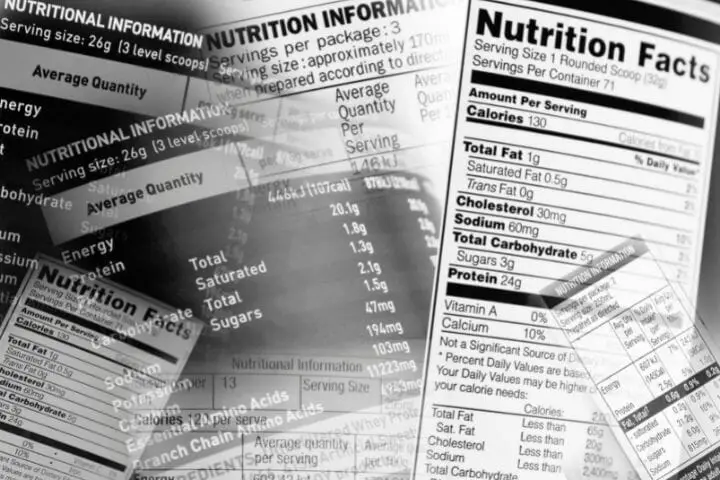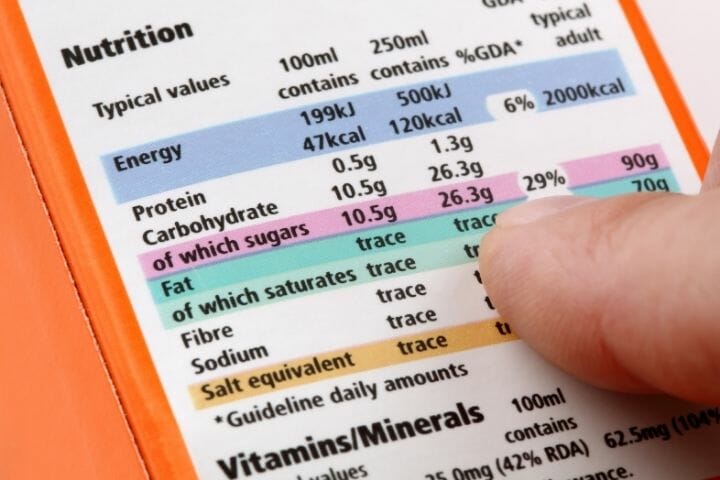In this guide, we will teach you how to read food labels without getting confused.
Contents
Most people find reading food labels tricky. People need to learn and understand the terms of food labels. You can stock a nutritious kitchen with proper education about the package ingredients list and expiration date.
People often get confused by “best by” or “sell by” as they wrongly believe that the food product is no longer safe to eat after this date. However, the food companies made these labels to determine the freshness of their products.

According to a study, 84% of people throw out their food products when they find the package best by date is close. Many consumers get confused by food labels, and only half of the consumers can understand nutrition labels.
If you want to know the secret of reading a food label, first you have to know what to look for in food packages.
How Do You Read Food Labels Effectively?
Avoid front package claims in every food product.
Most packaged foods use misleading food claims on the front of the package or box food. You should avoid the front package claims as not all claims are beneficial. The manufactures use these front package marketing claims to trick people into buying unhealthy food products.
However, some claims have merits that have strict standards labels such as Regenerative Organic Certified, USDA Organic, and Non-GMO.
Avoid food products with front package claims such as “good source of fiber,” “made with whole grains,” or “made with real fruit.” These claims are shallow and used by manufacturers to hide the fact that it includes unhealthy ingredients like corn syrup.
Experts advise people to look for minimal processed, real foods. You can also shop for natural foods like veggies, fruits, seeds, nuts, eggs, fish, and meat at local farms.

Thoroughly examine the ingredient list.
Generally, manufacturers list the ingredients by their quantity from highest to lowest. You should look for products that list at least three whole foods on the top of the ingredients list. Ideal nutrient-dense whole foods are nuts, seeds, and other whole foods.
However, if the first ingredients on the list are refined grains, hydrogenated oils, or a type of sugar, you should not shop for that product as it is unhealthy.
Your goal is to be able to recognize most of the ingredients listed. If you cannot identify the process or any component of the product, you should avoid it. If you shop for food products that contain added sugar, the sugar must be listed at the end of the list.
After going through the ingredients list, you should check the list of allergens. The usual list of allergens includes milk, fish, egg, shellfish, peanuts, tree nuts, soy, and wheat. If you are sensitive to these allergic ingredients, you should avoid purchasing any allergen products.
Don’t forget to watch out for serving sizes.
Food industries list the serving size at the top of most food products. It helps people determine the serving size of one package and indicates the volume of food associated with the food label.
You can eat multi-serving food by yourself. However, it is not healthy; you should pay attention to the serving size of the products. Nutrient labels state the number of calories and nutrients for a single serving.
However, these serving sizes can many times be inaccurate and smaller than what people consume in real life. You should focus on choosing high-quality ingredients, fiber, healthy fats, and food that stabilize blood sugar levels with a balance of proteins.
Know your sodium needs
Sodium is an essential nutrient for overall health. It helps people absorb other nutrients and maintain proper fluid balance. Doctors advise people to eat less salt to avoid high blood pressure. The recommended universal limit of consuming salt is 2,300mg per day.
When you shop for food products, removing the worst sodium offenders is important. Avoid ultra-processed foods and fast foods as they contain the most sodium amount.
Since most manufacturers use sodium in preservation, you should avoid canned food and highly processed food. Sodium is also high in products with added sugars, carbohydrates, and unhealthy fats.
Get familiar with fats.
The fats that support your blood sugar balance and help increase good cholesterol are healthy. Some food products that contain healthy fats are virgin olive oil, nuts, olives, avocado, and seeds. Usually, manufacturers list the total fats, along with trans fat and saturated fat.
Experts advise opting for monounsaturated fats in the diet. You should avoid trans fat as it has a negative impact on HDL and LDL cholesterol levels. You can find trans fat in dairy products and meat. You should eat less than 20g of saturated fat in a day.

More fiber
Fiber helps support a person’s blood sugar level, digestive health, and hormonal health. You can get fiber from the carbohydrates, and it is listed just under carbohydrates.
You should buy food products that contain at least 4g of fiber per serving. However, the recommended daily intake for fiber is an average of 30g per day. You can get fiber from whole foods such as beans, fruits, starchy and non-starchy vegetables, and whole grains.
Less sugar
After the fibers, manufacturers list the sugar under carbohydrates in the ingredients list. Scientists state that sugar forms in two ways; naturally and artificially. Usually, the sugar naturally occurs in whole foods, and some food industries use added sugar in the product to increase the sweetness.
Experts advise using sugar more than 5 grams per serving to avoid increased blood sugar. Doctors recommend eating food products with added sugar limited to 12g per day.
Limit carbs
Carbohydrates are found in different types, from refined to whole carbohydrates. It is present in most food products such as bread, kale, berries, vegetables, and pretzels. Carbohydrates contain both sugar and dietary fiber and can increase the level of both in your body.
You should limit the overconsumption of net carbohydrates in your meal. Experts recommend avoiding all refined carbohydrates such as rice flour, white rice, and enriched wheat flour. You should calculate the net carbohydrate you intake by the total carbohydrate and dietary fiber difference.
Be mindful of the protein.
You should add protein to your diet. Protein consists of amino acids that are often the building blocks of all cells, tissues, and organs in our body. It also helps in the formation of enzymes and hormones.
Protein has many benefits; it helps increase nutrition, support body mass and metabolisms, and prevent hunger for hours after the last meal. Experts recommend buying food with a ratio of 2:1 of carbohydrates to protein.

What To Look for on Food Labels To Lower Cholesterol?
Generally, the food industry lists cholesterol in the ingredients list below the fats. You should combine the grams of both saturated fat and trans fat. After merging, select the product with the lower combined amount of fat.
Eating cholesterol in your diet does not cause the production of high cholesterol in your lipids. However, you can also look for the cholesterol percent Daily Value.
Food products with ingredients such as refined grains and added sugar can increase the body’s cholesterol levels. You should avoid packaged foods with high carbs.
What Is the 5/20 Rule?
5/20 is an excellent rule that helps grocery shoppers to find food products that are more nutritious than others. You can apply this 5/20 rule to any nutrient goals.
The 5/20 rule determines that when planning a diet, try maximizing nutrients that you need to 20% and minimizing the nutrients that you don’t need to 5%.
For example, your nutritionist tells you to take a diet that boosts your protein intake while reducing your sugar intake. You should buy food products that provide over 20% of the daily value of protein and below 5% of the daily value of sugar necessary for your goal diet.

What Can Be Confusing About Food Labels?
Most people often get misled by the package’s date. However, the food product industry simply uses these dates to determine the product’s optimal quality. Most manufacturers generally apply date labels for a variety of reasons.
The primary function of date labels is to inform the consumer and retailer when they can get the best-desired quality and flavor.
Different names for the same ingredient can also confuse many people—for example, other names of sugar. Manufacturers use different names to hide the actual amount.
Types of sugar that may include in a food product are:
- Beet sugar
- Coconut sugar
- Brown sugar
- Buttered sugar
- Cane sugar
- Date sugar
- Invert sugar
- Organic raw sugar
- Evaporated cane juice
- Raspadura sugar
- Golden sugar
Don’t confuse the different names of sugar, and avoid buying food with added sugar calories.

Wrap Up
You can get essential information on reading food labels from this article to help you maintain your healthy diet. You should avoid processed foods to prevent confusion by product labels and use whole food instead. However, you can use packaged foods after checking their quality and health benefits.
If your healthcare provider orders you to use a diet low on cholesterol, you should watch out for good cholesterol and fats in the ingredients list.
